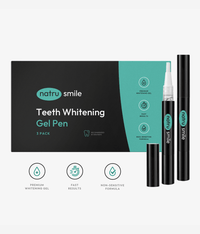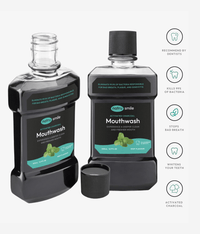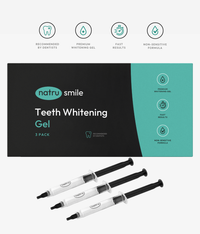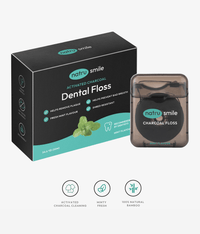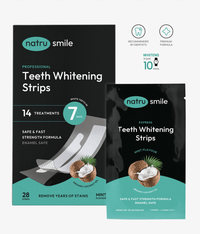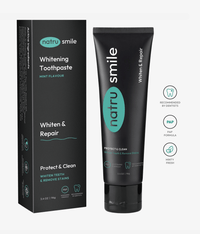
All products are certified by dental expert Dr. Greg Grillo
Those who want to get the most out of their oral hygiene routine can see better results and a cleaner smile using an electric toothbrush. This article looks at 14 essential considerations when making a purchase and what to look for in your new toothbrush.
Used by over 130 million Americans, electric toothbrushes are all the rage in modern dental care.
Their ability to remove more plaque, clean more effectively, and be more gentle on your gums, make them an attractive choice for many.
Of course, not all electric toothbrushes are created equal—some work wonders for your teeth while others are a waste of money.
In this article, we'll show you exactly what you should look for and what to avoid when picking out a new electric toothbrush.
Checklist: What To Look For When Buying An Electric Toothbrush
- Bristle stiffness
- Oscillating motion
- Size
- Range of settings
- The ADA Seal of Acceptance
- Cost or value
- Refund policy
- Number of brush strokes per minute (BPM)
- Timer/quadrant pacer
- Range of cleaning modes
- Pressure sensors
- Waterproof
- Charging method
- Rechargeable or disposable batteries
Types Of Electric Toothbrushes
There are two kinds of electric toothbrushes available: oscillating-rotating and sonic motion.
The dental community is divided on which option is better for improving your smile, but each offers a different approach and benefits.
Oscillating-Rotating Toothbrushes
Oscillating-rotating toothbrushes are more common than other electric toothbrushes. They feature a round head of bristles that rotate and oscillate back and forth to provide rapid cleaning action.
The motion is often described as “scrubbing” your teeth, which allows it to remove more plaque and bacteria than manual brushing can. It can be as fast as 8,800 brush strokes per minute, depending on the model.
Sonic Toothbrushes
Sonic toothbrushes feature a small, flat head of bristles that vibrate rapidly to clean your teeth.
They use a high-frequency vibration to break up plaque and bacteria on your teeth, providing an even deeper cleaning than oscillating-rotating models.
To be classified as such, a sonic toothbrush must have a minimum of 50,000 movements per minute. Because they move so fast, the distinctive characteristic of a sonic toothbrush is its audible hum.
14 Essential Criteria For Evaluating An Electric Toothbrush
When choosing an electronic toothbrush, you will need to evaluate it on multiple criteria. Although the list is long, most of these are fairly straightforward—you will be able to judge most of them based on their appearance and packaging alone.
Bristle Stiffness
Toothbrushes are labeled as "extra soft," "soft," "medium," or "hard" based on bristle stiffness. The ADA strongly recommends using an electric toothbrush with soft bristles, as harder bristles can harm the enamel, root surfaces, and gum line.
The stiffness of your bristles makes a significant difference on regular toothbrushes. That impact is amplified when you’re dealing with an electric toothbrush. Because of how fast electronic toothbrushes oscillate or vibrate, they can erode your gums much faster if you don't follow the ADA guidelines for properly brushing your teeth.
In addition to proper brushing techniques, choosing a soft-bristled toothbrush is the best option for the health of your teeth and gums.
Oscillating Motion
As we previously mentioned, oscillating-rotating and sonic are the two main electric toothbrush types.
Oscillating-rotating toothbrushes are more popular, featuring a round or ovular head and bristles that rotate and oscillate back and forth. The amount of rotation and oscillation is determined by the model you choose, and you should look for one that offers at least 3,000 brush strokes per minute.
Sonic toothbrushes feature a small, flat head with bristles that vibrate rapidly. The most important thing to look for here is the number of vibrations per minute—it must be at least 50,000 in order to be classified as a sonic toothbrush.
Some users prefer oscillating toothbrushes for their scrubbing action, while others prefer sonic toothbrushes for their deep-cleaning vibrations. It all depends on personal preference—either will get you the results you need.
Size
A toothbrush that is too large won't fit properly into the crevices of your mouth, and you'll miss critical debris and food particles that can build up over time.
If your electric toothbrush head is too small, it won't give you the right coverage, and you won't get the full benefit of the brush.
Different people have different preferences when it comes to size, but the ADA recommends using a toothbrush head that is no more than 0.5 inches wide by 1 inch long.
Your toothbrush handle should also be long enough to comfortably fit into your hand, allowing you to reach every surface of your teeth.
Range Of Settings
Most electric toothbrushes only have one setting: On.
Some high-end models will have different modes for sensitive teeth and whitening, as well as timers and QuadPacer technology to help you keep track of the time you spend brushing each quadrant of your mouth.
These features can be extremely helpful, but they are not necessary—particularly if you’re just starting out with an electric toothbrush.
The ADA Seal Of Acceptance
The ADA Seal of Acceptance is an approval from the American Dental Association that ensures a product meets certain standards for safety and effectiveness.
To earn this seal, manufacturers must demonstrate that their product is both safe and effective—meaning it can actually help reduce plaque and improve your oral health.
Usually, the brand will proudly display this seal on its packaging. If you don't see it, you can do a quick online search to double-check.
Cost Or Value
According to Consumer Reports data, pricing for electric toothbrushes varies wildly from under $10 for battery-powered models to over $200 for rechargeable lithium-ion products.
The reality is that neither option is best. To find the best electric toothbrush for you, you'll have to evaluate the cost against how much value you can get from it.
Look for features that will help you get better results—such as wireless connectivity, long battery life, and multiple brush heads. You should also factor in the cost of replacement heads, which can add up quickly if you don't buy them in bulk.
Most quality electric toothbrushes will range between $75 and $150. In this range, you'll find products from reputable brands that sell their products in numerous stores and online.
Refund Policy
Most of the major brands in the dental care space offer a satisfaction guarantee. This means that if you are not satisfied with your purchase, you can return it for a full refund.
Your electric toothbrush should also have a warranty—if it breaks within a relatively short time period, you should be entitled to a replacement.
The only part you shouldn't expect to find warrantied is the brush head, which is designed to be replaced every three months.
Number Of Brush Strokes Per Minute (BPM)
Most electronic toothbrushes will meet this criterion—strictly speaking, anything over 3,000 brush strokes per minute is enough to qualify as an electric toothbrush.
But the number of BPM isn't everything—it's also important to look at the type of stroke. Sonic models create tiny pulses that help dislodge even hard-to-reach plaque and food particles from your teeth and gums.
Rotary models, on the other hand, use circular motions to break up plaque and buff away stains.
Timer/Quadrant Pacer
Some electric toothbrushes come with a built-in timer. This ensures users brush for the full ADA-recommended two minutes, which is important for optimal oral health.
A Quadrant Pacer takes this feature to the next level, telling you when to switch quadrants and helping you keep track of the time spent on each section of your mouth.
It's an incredibly helpful feature, as it helps ensure that all areas of your teeth get the same attention during brushing.
Range Of Cleaning Modes
Some toothbrushes (like the NatruSmile electric toothbrush) have multiple oscillation or vibration settings for ultra-cleaning and polishing, teeth sensitivity, and gum massage.
There are several benefits to having these settings:
-
Customizable Cleaning: Different modes can give you a more personalized cleaning experience, allowing you to target specific areas and tailor your brushing routine.
-
Gentle Cleaning Option: Some people may need a gentler cleaning option due to sensitive teeth or gums. These settings reduce the pressure applied to the teeth and gums while still providing an effective clean.
- Teeth Sensitivity Protection: Some modes are designed to protect teeth from sensitivity by using a softer, gentler cleaning action.
The best electronic toothbrushes will make your routine easier and more personalized by offering these settings.
Pressure Sensors
Excess pressure can lead to gum recession and enamel erosion, which can ultimately cause tooth sensitivity and other dental issues.
To help avoid this, some electric toothbrushes have a built-in pressure sensor. If you press too hard, the brush will vibrate or stop oscillating altogether as a reminder to lighten up your brushing technique.
Waterproof
Since your new toothbrush will be powered by electronic components, you'll want to make sure it's waterproof. If you clean your electric toothbrush or submerge it in water, it needs to be able to continue working.
Look for toothbrushes that are rated as IPX7 or higher—this means they can be totally submerged in water up to 1 meter deep and still continue functioning.
You should also look at the brush handle itself—a waterproof handle will have a rubber or silicone coating, making it easier to grip and hold during use.
Charging Method
There are two primary ways to charge an electric toothbrush: on a charging base or with a USB cord.
Both are completely fine. They are just different methods of supplying power to the brush.
Charging bases are often more convenient, as they generally hold a charge for longer and don't require you to use a USB cord. Still, some users prefer USB cords because they are slightly more compact and easy to travel with.
Rechargeable Or Disposable Batteries
If you purchase a disposable-battery-powered electric toothbrush because it is more cost-effective in the short term, be aware that you'll need to replace the batteries periodically.
This can be a bit of a hassle—not to mention an additional expense. Batteries are expensive, and you will end up spending more money over the years while inconveniencing yourself every time you need to replace them.
Rechargeable brushes, on the other hand, are a much better option in the long run because they require less upkeep and last for many years. One of the recharging methods above (USB or charging base) is what you should look for, and they usually come included with your initial purchase.
Which Type Of Electric Toothbrush Is Best For You?
Dozens of clinical studies have highlighted the clear advantages of electronic toothbrushes over normal ones. But which kind is right for your teeth?
When deciding between oscillating-rotating and sonic brush heads, it all comes down to your preferences.
Sonic brushes offer slightly better coverage and significantly faster brushing speeds. But some users report better success with oscillating-rotating brushes when it comes to removing plaque and stains.
The best way to determine which one works best is to try them both—you may even want to try a few different models.
What Are LED Electric Toothbrushes?
A newer type of electric toothbrush uses LED technology designed for those using teeth whitening toothpaste. Typically, this involves a cold blue LED light and a warmer red one.
Blue LED light (450nm - 495nm) lifts the appearance of existing stains and enhances whitening more efficiently.
Red LED light (620nm - 750nm) reduces the feeling of tooth sensitivity and relieves oral discomfort.
Both of these colors benefit the whitening process and make the overall brushing experience more effective.
How Often Should You Change Your Electric Toothbrush Head?
To keep your teeth and gums as clean as possible, you should change the head out every 3 months. This will ensure that you’re getting the most effective cleaning and brushing possible, as well as preventing bacteria from collecting on the brush head over time.
The Bottom Line
Electric toothbrushes are a better alternative to traditional ones and can offer a wide range of benefits for your teeth and gums.
Using the list above, you’ll be able to determine which electric toothbrush is best for you and how often you should replace the head.
Remember, taking good care of your teeth will help keep them healthy and give you a beautiful smile that can last a lifetime.


